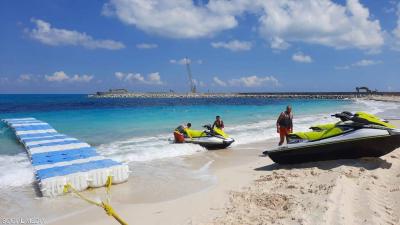Egyptian media reported on Friday that a diver in the North Coast waters, overlooking the Mediterranean Sea, was allegedly attacked by a shark. The diver, identified as Tarek Khalaf, 58 years old, arrived at Alamein Hospital claiming to have been attacked by a shark while swimming about 3 kilometers offshore. Upon examination, he was found to have a severe laceration in his left arm.
The injured diver underwent major surgery to stitch the 20 cm long and 5 cm wide laceration, through which the bones of his hand were visible at Alamein Hospital.
The Egyptian Ministry of Environment released a statement revealing the truth about the incident. The confirmed information indicated that the diver was not attacked by a shark. The doctors treating the patient examined the injury and stated that it was caused by a cut from a sharp object and not a marine creature. The statement noted that "environmental experts examined the wound, which did not match the nature of injuries typically documented globally as resulting from shark attacks on humans."
Environment Minister Yasmin Fouad mentioned that surveys and monitoring of the Mediterranean waters would continue to assure citizens and ensure their safety and protection. The ministry is also monitoring developments closely to clarify the complete truth.
The head of the National Institute of Oceanography and Fisheries, Amr Hamouda, commented that the wound shown in circulated images on social media appears on the palm of the left hand and is a single line, suggesting that if the narrative were true, a "shark entered between his head and arm."
Hamouda added that the Minister of Higher Education has ordered a research team to investigate the matter on-site, with members visiting the injured diver in the hospital and inquiring about the details of the incident. The diver allegedly claimed he was 300 meters from the shore when the shark was about 7 meters below him; it attacked in less than a second, prompting him to swim on his back until he reached the shore, asserting that the shark could swim at 60 kilometers per hour.
Hamouda emphasized that a shark does not have just one tooth but a set of teeth that would leave marks on the victim’s body, and that a shark attack involves multiple teeth, not just one. The doctors at the hospital where the attack victim was transferred stated that the injury was from a sharp object because they are well-acquainted with how shark injuries occur.
A research vessel was dispatched to the site of the incident to survey the area and inspect the seabed using modern devices to determine if there are shark populations present. Hamouda explained that any marine creature moves towards the shore when it loses control and is pulled in by the waves, and therefore it cannot be conclusively asserted that the fish that attacked the diver was a shark; it could have been a "dolphin."




